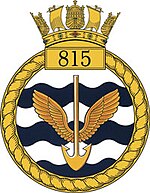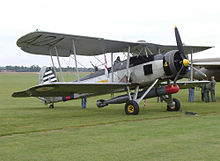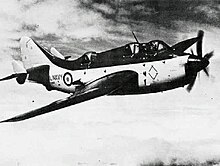| 815 Naval Air Squadron | |
|---|---|
 Squadron badge Squadron badge | |
| Active |
|
| Country | |
| Branch | |
| Type | Helicopter flying squadron |
| Role | Maritime attack |
| Size | Approx. 240 personnel |
| Part of | Fleet Air Arm |
| Home station | RNAS Yeovilton (HMS Heron) |
| Motto(s) | Strike Deep |
| Website | Official Twitter |
| Commanders | |
| Current commander | Commander James Woods |
| Aircraft flown | |
| Helicopter | AgustaWestland Wildcat HMA2 |
815 Naval Air Squadron is a Royal Navy Fleet Air Arm squadron flying the AgustaWestland Wildcat HMA.2 helicopter and is the Navy's front line Wildcat Naval Air Squadron. The squadron is based at RNAS Yeovilton (HMS Heron) in Somerset. The squadron is capable of carrying out multiple roles such as: counter-narcotics, anti-piracy, Above Surface Warfare (ASuW), search and rescue, disaster relief and flying and engineering training. In the early 2000s, the Navy said that the squadron was largest helicopter squadron in Europe.
History
Second World War


The squadron formed at RNAS Worthy Down on 9 October 1939, from the remnants of 811 and 822 squadrons that had survived the sinking of their carrier HMS Courageous in September 1939, with Fairey Swordfish aircraft. The squadron disbanded in November 1939 but reformed the same month. In May 1940 the squadron provided support to the Dunkirk evacuation. In June 1940, the squadron embarked on HMS Illustrious and sailed for the Mediterranean in August, attacking and minelaying Benghazi, Rhodes and Tobruk. The squadron gained early fame with its involvement in the Battle of Taranto in 1940, when the Italian Battlefleet in harbour at Taranto was raided; which redefined the use of air power from the sea. The aircraft of the commanding officer was lost, against the crippling of half the Italian fleet. In March 1941, the squadron fought in the Battle of Cape Matapan. The squadron re-equipped in August 1941, with a mixture of Swordfish and Fairey Albacore aircraft, operating from shore bases in support of the North African campaign. In July 1943, 815 Squadron was assigned to No. 201 (Naval Co-operation) Group with a detachment of Swordfish assigned to AHQ Malta; the units participating in Operation Husky on 10 July 1943, before 815 Squadron was disbanded.
On Fairey Barracudas

The squadron reformed in October 1943 at RNAS Lee-on-Solent (HMS Daedalus) to operate Fairey Barracuda torpedo bombers, operating from Indomitable with the Eastern Fleet, attacking targets in Sumatra, August–September 1944. In November 1944 the squadron disbanded and reformed in December at RNAS Machrihanish (HMS Landrail), flying Barracudas for anti-submarine operations, the following month being spent doing DLT (deck landing training) on HMS Campania. The squadron was transferred to the Far East aboard HMS Smiter but saw no action before VJ-Day and returned to the UK in September 1945 aboard HMS Fencer.
Post war
Avenger and Gannet


The squadron disbanded some time after the war and reformed in 1947 from 744 Squadron, flying Grumman Avengers, which were replaced with Fairey Gannets, the last fixed-wing aircraft of the squadron when it disbanded at RNAS Culdrose (HMS Seahawk), July 1958.
Westland Whirlwind
In September 1958, the squadron reformed on Westland Whirlwind HAS.7 helicopters, moving to RNAS Portland (HMS Osprey) when engine trouble started to plague the Whirlwinds. The squadron eventually disbanded here in August 1959 by being renumbered to 737 Squadron. The squadron reformed again on 8 September 1959, still on Whirlwinds and after a Far East tour on HMS Albion, it disbanded again in December 1960.
Westland Wessex

On 4 July 1961, the squadron recommissioned at RNAS Culdrose with the Westland Wessex HAS.1. The squadron embarked on HMS Ark Royal in November 1961, moving to HMS Centaur in 1964 and provided support against disturbances in Aden and in Tanganyika (now Tanzania). After a final deployment on Ark Royal, the unit disbanded at RNAS Culdrose in October 1966.
Westland Lynx

In January 1981, after a gap of some 15 years, the squadron re-commissioned at RNAS Yeovilton (HMS Heron) with the Lynx HAS.2 as the Headquarters Squadron for embarked Lynx Flights. It then moved to RNAS Portland (HMS Osprey) in 1982 and it saw action during the Falklands War of 1982. The flights were shared with 829 Naval Air Squadron until they were amalgamated in 1993, to become the largest helicopter squadron in the world. In 1998–99 after an absence of nearly 17 years, the unit moved back to RNAS Yeovilton, with the closure of RNAS Portland.
In September 2000 a Lynx Helicopter from 815 NAS took part in Operation Barras. The aircraft, flown by Lt Cdr Al Jones and Lt Nigel Cunningham as the Observer flew over 30 missions deep into the Sierra Leone Jungle. In 2002, a Lynx from 815 Squadron crashed into the Atlantic Ocean while participating in a joint British–American exercise, with the loss of the pilot, Lieutenant Rod Skidmore and observer, Lieutenant Jenny Lewis. Several of the Lynx helicopters are stated as part of the Response Force Task Group. In July 2012, three Lynx helicopters supported the Olympics security operation embarked on HMS Ocean tasked with intercepting aircraft that entered restricted airspace. In November 2012, the Lynx of 217 Flight deployed to the Horn of Africa for four months on board the French frigate Surcouf, the first extended deployment of a British helicopter on a French warship.
AgustaWestland Wildcat

The squadron currently operates the AgustaWestland Wildcat HMA.2 which replaced the Lynx HMA.8. The squadron received the first four of twelve Wildcats in April 2016. The retirement of the Lynx fleet began in December 2014 and was completed in March 2017.
Current composition
The squadron is composed of a Headquarters and fifteen flights and an attached Maritime Interdiction (MI) Flight. The squadron's Small Ship's Flights embark in Type 23 frigates, Type 45 destroyers or Royal Fleet Auxiliary ships. In September 2018, 213 Flight conducted the first Wildcat landing on a Queen Elizabeth-class aircraft carrier. The Maritime Interdiction (MI) Flight is maintained at high readiness to provide support and assistance to counter-terrorism in the UK.
In 2014, the Navy said after the squadron completes the transition from the Lynx to the Wildcat the squadron would consist of twelve single-manned flights at readiness for deployed operations worldwide and two double-manned Maritime Counter Terrorism (MCT) flights at very high readiness in the UK.
Aircraft flown

The squadron flies the Wildcat HMA.2. A list of aircraft that have been flown by 815 Naval Air Squadron include:
- Fairey Swordfish Mks.I, II
- Fairey Albacore Mk.I
- Fairey Fulmar Mks.I, II
- Fairey Barracuda Mk.II, TR.3
- Grumman Wildcat Mk.VI
- Fairey Firefly T
- Grumman Avenger TBM-3E, AS.4, AS.5
- Fairey Gannet AS.1, T.2, AS.4
- Westland Whirlwind HA.R3, HAS.7
- Westland Wessex HAS.1
- Westland Lynx HAS.2, HAS.3, HMA.8
- AgustaWestland Wildcat HMA.2
Battle honours
815 Naval Air Squadron has received the following battle honours.
- North Sea 1940
- Mediterranean 1940–42
- Taranto 1940
- Libya 1941–42
- Matapan 1941
- Burma 1944
- East Indies 1944
- Falkland Islands 1982
- Kuwait 1991
References
Citations
- ^ "815 Naval Air Squadron". Royal Navy. Retrieved 28 August 2022.
- ^
 This article incorporates text published under the British Open Government Licence v3.0: "815 Naval Air Squadron". Royal Navy. Archived from the original on 5 June 2014.
This article incorporates text published under the British Open Government Licence v3.0: "815 Naval Air Squadron". Royal Navy. Archived from the original on 5 June 2014.
- ^ "Introduction - 815 Naval Air Squadron". Royal Navy. Archived from the original on 20 February 2003.
- ^ "815 Squadron". fleetairarmarchive.net. Fleet Air Arm Archive. Archived from the original on 24 September 2015. Retrieved 12 August 2007.
- ^ Thetford 1994, p. ?
- ^ "815 Squadron Fleet Air Arm, 1939 to present". helis.com. Retrieved 2 April 2011.
- ^ "815: History". royalnavy.mod.uk. Royal Navy. Retrieved 26 March 2009.
- "Navy officers feared dead". BBC News. BBC. 13 June 2002. Retrieved 1 September 2014.
- "Royal Navy". Archived from the original on 11 December 2010. Retrieved 11 December 2010.
- "The carnival is over" (PDF). Navy News. HMS Nelson, Portsmouth: Royal Navy: 23. October 2012. ISSN 0028-1670. Retrieved 29 August 2022.
-
 This article incorporates text published under the British Open Government Licence v3.0: "The Royal Navy supporting the 2012 Olympic Games" (PDF). Royal Navy. Archived from the original (PDF) on 17 August 2012.
This article incorporates text published under the British Open Government Licence v3.0: "The Royal Navy supporting the 2012 Olympic Games" (PDF). Royal Navy. Archived from the original (PDF) on 17 August 2012.
- "From frigate to frégate… Lynx team joins French warship on deployment". Navy News. 19 October 2012. Archived from the original on 13 August 2014. Retrieved 7 December 2012.
- ^ "Wildcat pride heralds new era for 815 NAS". Royal Navy (Press release). 19 April 2016. Retrieved 19 April 2016.
- "Veteran Lynx retires after 35 years' service". Royal Navy (Press release). 23 December 2014. Archived from the original on 9 January 2015.
- "Maritime Lynx passes into history". Royal Navy (Press release). 24 March 2017. Archived from the original on 6 May 2017.
- "First Wildcat to land on HMS Queen Elizabeth returns home in time for Christmas". Royal Navy (Press release). 13 December 2018.
- Royal Naval Air Station Yeovilton (4 September 2018). "the #first Wildcat HMA2 Helicopter to land on @HMSQnlz" (Tweet). Retrieved 29 August 2022 – via Twitter.
- Kwiatkowski, Mark (13 February 2017). "Royal Navy Lynx Retirement". AeroResource. Retrieved 28 August 2022.
-
 This article incorporates text published under the British Open Government Licence v3.0: "The Lynx Wildcat evolution". Royal Navy (Press release). 23 May 2014. Archived from the original on 28 May 2014.
This article incorporates text published under the British Open Government Licence v3.0: "The Lynx Wildcat evolution". Royal Navy (Press release). 23 May 2014. Archived from the original on 28 May 2014.
- "SQUADRONS OF THE FLEET AIR ARM 2009". fleetairarmoa.org. The Fleet Air Arm Officers' Association. Retrieved 2 April 2011.
- "SQUADRONS OF THE FLEET AIR ARM 2009". fleetairarmoa.org. The Fleet Air Arm Officers' Association. Retrieved 2 April 2011.
Bibliography
- Thetford, Owen (1994). British Naval Aircraft since 1912 (4 ed.). London: Putnam. ISBN 0-85177-861-5.
- Sturtivant, Ray; Theo Ballance (1994). The Squadrons of the Fleet Air Arm (2 ed.). Tonbridge, Kent, UK: Air Britain (Historians) Ltd. ISBN 0-85130-223-8.